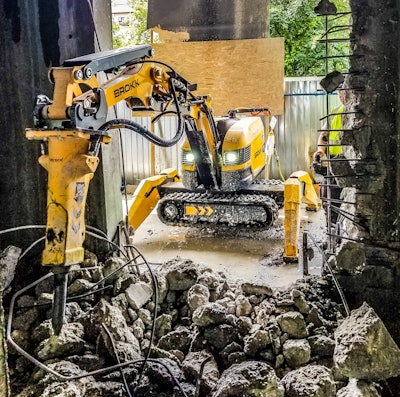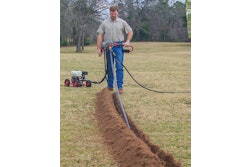
By August Scalici and Jeff Keeling
Minimizing effort and maximizing efficiency on any job requires the right tool. For concrete demolition contractors determining which machine provides the optimal power-to-weight ratio for the task at hand should be the first consideration. Many options are available — from heavy-hitting multi-ton excavators to handheld pneumatic devices — but remote-controlled demolition machines are proving successful for many demolition contractors. These machines provide the power, versatility and efficiency to master a number of applications, especially in congested urban areas such as indoor and top-down demolition.
The important decisions don’t stop with the carrier. Bit selection also has a significant impact on demolition efficiency. Identifying the right bit for the task at hand can increase efficiency, while a mismatch can slow down productivity or leave behind unsatisfactory results. Knowing the difference gives savvy contractors a huge advantage in an increasingly competitive field.
A toolbox full of bits isn’t necessary for every concrete demolition contractor, though. It all depends on application. Our experts have provided some tips to help select the right tools to keep on hand for maximum efficiency with remote-controlled demolition machines.
Every Contractor’s Friend: Moil Point
The most common bit found on jobsites is the moil point. It’s shaped like a pencil and is ideal for breaking hard concrete reinforced with rebar. This design focuses the entire force of the hammer and carrier in a 1/4-inch point, therefore limiting vibrations. It is an optimal choice for situations where vibrations are unacceptable — like indoor applications. The moil point is the everyday workhorse of concrete demolition, providing high-efficiency and reliability, leading to it being the standard bit for most new breakers.
 Brokk
Brokk
A lack of knowledge often leaves operators stuck with the traditional cone-shaped moil, but there are several variations of the moil point that offer further efficiency in certain situations. A pyramidal moil point, also known as a “nail head”, for example, provides minor torsion and a wedge effect in four directions, making it more efficient as a dividing tool than a conical moil. This is especially true for larger diameter tools. The slight variation in shape also keeps the “nail head” from getting stuck as often.
Detail Oriented: Chisel
A chisel tool looks similar to a flat-head screwdriver and is available in standard and wide widths. The chisel provides strong torsion and good penetration, resulting in the best splitting action. It is ideal for trimming applications, including floors, walls and foundations, as well as demolishing reinforced columns, supports and blocks. For example, the chisel can be used to clean up between rebar on the edge of a slab to ensure an ideal bonding surface for pouring concrete.
This tool also offers the best precision for fine detail work, allowing operators to remove a little concrete at a time, such as shaving down high points or blowouts from slurry walls.
The chisel doesn’t offer the versatility of a moil point, but it belongs in every concrete demolition contractor’s toolbox for specialized applications that call for a delicate touch.
Heavy Hitters: Blunt
This tool features a flat face with more surface area to deliver a wider area of impact when breaking slab concrete. The blunt tool is ideal for floors, recycling, steel beams encased in concrete and certain roadwork applications. The blunt tool makes up for a lack in precision with greatly increased destructive power. Energy is distributed across the whole face of the tool, covering a significantly larger surface area than moil and chisel bits for maximum breaking efficiency.
Working with a blunt tool produces additional vibrations. This limits its use in certain situations like indoor and top-down demolition and some road and bridge repair applications. However, the vibrations also make this an ideal tool for removing concrete from around steel beams since it encourages the concrete to walk away from the steel for easier removal. This tool can also be used for bridge beam testing since it can create a pocket just small enough to inspect the steel beam beneath the concrete.
Maximum Destruction: Slab Buster
When a project calls for maximum destructive power, the slab buster, or “elephant foot,” is the ideal choice. Like the blunt tool, it uses a wider surface area and can double production of both slab and on-grade demolition. The slab buster is shaped like a bell and distributes energy over a surface area three times its size.
The slab buster also creates powerful vibrations and provides very little precision, so it is not ideal for every situation. However, for a thin slab floor with no vibration restrictions, this tool offers maximum demolition efficiency.
So, What’s in Your Toolbox?
 Brokk
Brokk
August Scalici is a field sales application expert at Brokk. He has worked for the company for 20 years and has more than 35 years of experience operating Brokk machines. Jeff Keeling is the North American sales & marketing manager for Brokk Inc. He works closely with regional sales managers to develop and grow the company's brand in key segments across the United States and Canada. Both are responsible for educational initiatives aimed at helping customers maximize their Brokk machines’ potential.



















